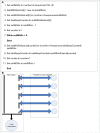IVisTMSA: Interactive Visual Tools for Multiple Sequence Alignments
- PMID: 25861209
- PMCID: PMC4362671
- DOI: 10.4137/EBO.S18980
IVisTMSA: Interactive Visual Tools for Multiple Sequence Alignments
Abstract
IVisTMSA is a software package of seven graphical tools for multiple sequence alignments. MSApad is an editing and analysis tool. It can load 409% more data than Jalview, STRAP, CINEMA, and Base-by-Base. MSA comparator allows the user to visualize consistent and inconsistent regions of reference and test alignments of more than 21-MB size in less than 12 seconds. MSA comparator is 5,200% efficient and more than 40% efficient as compared to BALiBASE c program and FastSP, respectively. MSA reconstruction tool provides graphical user interfaces for four popular aligners and allows the user to load several sequence files at a time. FASTA generator converts seven formats of alignments of unlimited size into FASTA format in a few seconds. MSA ID calculator calculates identity matrix of more than 11,000 sequences with a sequence length of 2,696 base pairs in less than 100 seconds. Tree and Distance Matrix calculation tools generate phylogenetic tree and distance matrix, respectively, using neighbor joining% identity and BLOSUM 62 matrix.
Keywords: FASTA; MSA Identity Matrix; MSA comparator; MSA editing tool.
Figures





References
-
- Sullivan OO, Zehnder M, Higgins D, Bucher P, Grosdidier A, Notredame C. APDB: a novel measure for benchmarking sequence alignment methods without reference. Bioinformatics. 2003;19:1. - PubMed
Publication types
LinkOut - more resources
Full Text Sources
Miscellaneous

